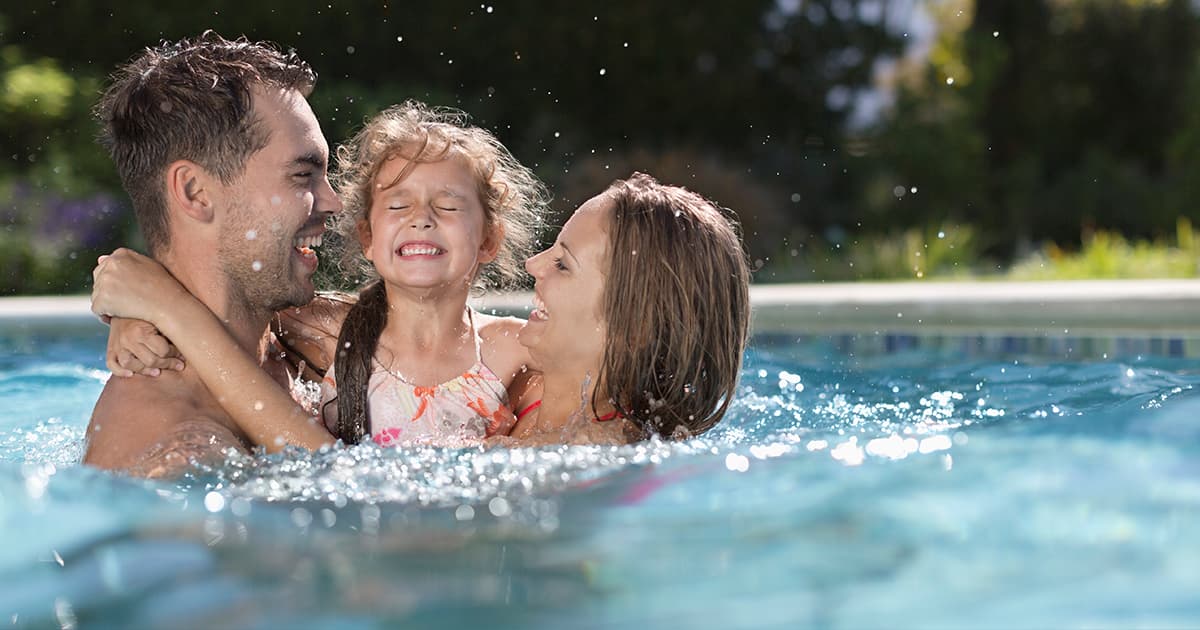Summer Water Safety: Must-Have Pool Insurance and Safety Measures

As summer approaches, many families look forward to spending time by the pool. Whether you own a backyard pool or hop in the car to visit a public pool, water activities are a great way to cool off and have fun.
To keep kids safe around water this summer, here’s what you need to know about necessary insurance coverage for pool owners, best ways to improve pool safety on your property, and how to keep kids safe around bodies of water in general.
Does your home insurance cover your swimming pool set up?
Homeowners insurance:
Typically, homeowners insurance does cover swimming pools under the “other structures” section of your policy. However, you’ll need to review your policy to ensure it specifically includes liability coverage for injuries that may occur in or around your pool.
Consider increasing your liability limits to cover potential medical expenses and legal fees in case of accidents for your kids, their friends, or neighborhood kids who may access your property unsupervised.
Umbrella insurance:
For additional protection, an umbrella insurance policy provides extra liability coverage beyond your standard homeowners policy. This is particularly beneficial if you frequently host pool parties or have a high number of guests using your pool.
Public liability insurance:
If you access public pools, ensure that the facility has adequate public liability insurance. This coverage protects you in case of an accident or injury at the public pool.
How to make your backyard pool safer:
Creating a safe environment around your pool is the best way to prevent accidents. Whether you’re working with an in-ground pool or a portable pool set up, here are some upgrades you might want to add to your summer home budget:
Fencing and gates:
Install a sturdy fence at least four feet high (1.2 metres) around your pool with self-closing and self-latching gates. Studies show that a four-sided isolation fence that separates the pool area from the house and yard reduces a child's risk of drowning by 83% compared to three-sided property-line fencing. This barrier helps prevent unsupervised access by young children. Drowning is the leading cause of unintentional injury-related death for children ages 1-4 years old, according to the Centers for Disease Control and Prevention (CDC), and incidents are far more likely to be serious when a parent or guardian isn’t on the scene.
Pool alarms:
Equip your pool with alarms that alert you when someone enters the pool area. Door alarms for entrances to the pool area and water surface alarms that detect disturbances can provide an added layer of security.
Safety covers:
Use pool safety covers when the pool is not in use. These covers should be strong enough to support the weight of a child and prevent accidental falls into the water.
Non-slip surfaces:
Ensure that the area around your pool has non-slip surfaces to reduce the risk of slips and falls.
Proper lighting:
Adequate lighting around the pool area increases visibility, reducing the risk of accidents during evening or nighttime swimming.
Secure storage of pool chemicals:
Store pool chemicals in a cool, dry place, away from children and pets. Ensure that all containers are tightly sealed and properly labeled. Follow manufacturer instructions for handling and mixing pool chemicals. Always add chemicals to water, not water to chemicals, to avoid dangerous reactions.
Personal pool safety measures
In addition to property Improvements, educating children, supervising children, and putting in place strict safety rules are vital to ensure their safety around pools:
Supervision: Distractions make for tragedies. Always supervise children when they are in or near the pool. Designate a responsible adult as a “water watcher” whose sole task is to monitor the pool area. Having a “water watcher” who is not distracted by other activities (like reading, talking, or using a phone) will prevent most serious accidents.
Swimming lessons:
Enroll children in swimming lessons to teach them how to swim and understand water safety basics. Knowing how to swim can significantly reduce the risk of drowning. Learning about water safety also can save lives.
Life jackets, pool toys, and floatation devices:
Ensure that non-swimmers or inexperienced swimmers wear appropriate life jackets or floatation devices. These should be approved by Transport Canada, Canadian Coast Guard, or Fisheries and Oceans Canada. They should fit properly.
Remember that floating pool toys do not count as proper flotation devices and aren’t a safe replacement.
Clear rules and boundaries:
Establish and enforce clear pool rules with your kids and their friends, such as no running, no diving in shallow areas, and no swimming without adult supervision.
First aid and CPR training:
Adults supervising children should be trained in first aid and CPR. Knowing how to respond in an emergency can save lives! Keep a first aid kit, a reaching pole, and a life ring near the pool. You can take an online course or ask a CPR professional to teach the proper use of these tools.
Safety First
By making sure you have the right insurance coverage, carefully building your property for pool safety, and adhering to strict supervision and safety rules, you can relax into a fun and safe summer with your family.
Switch and Save on your Car Insurance at Western Financial Group



